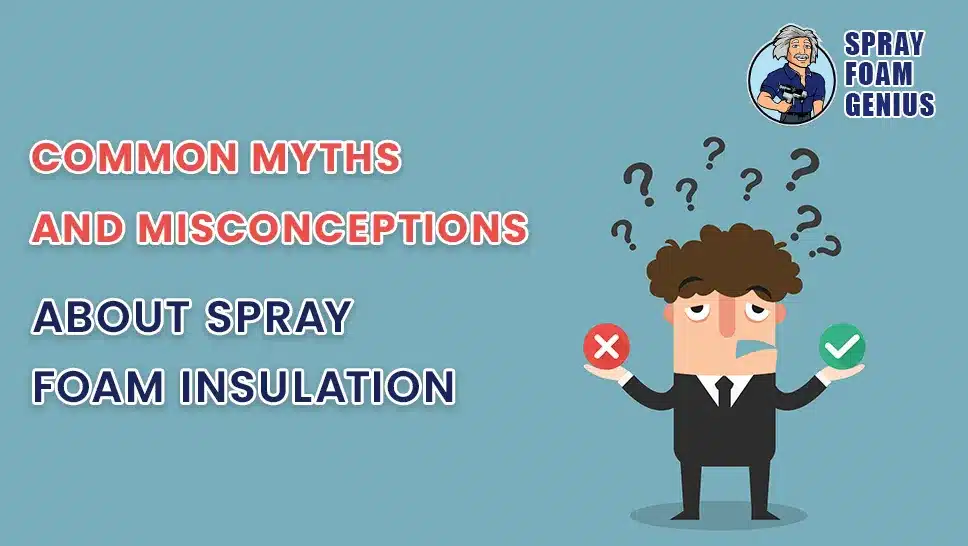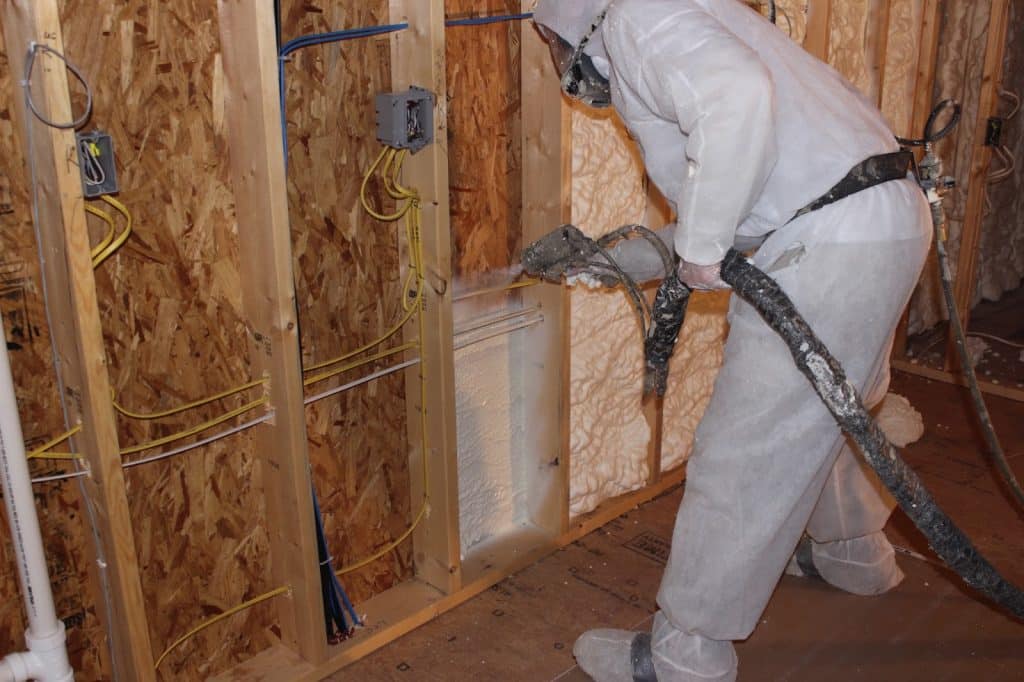
Spray foam insulation is an excellent choice for homeowners and businesses looking to enhance their energy efficiency, comfort, and indoor air quality. However, despite its many benefits, spray foam insulation is often misunderstood. As spray foam contractors, we at Spray Foam Genius Marketing work with spray foam insulation businesses across the USA and Canada, helping them clarify these misconceptions and educate potential customers.
In this post, we aim to address the most common myths and misconceptions surrounding spray foam insulation, providing clarity and expert insight to help you understand why it is one of the best solutions for modern insulation needs. We will also discuss how these myths may impact your business and how you can help debunk them to create better-informed customers.
1. Myth: Spray Foam Insulation Is Too Expensive
One of the most widespread myths about spray foam insulation is that it is too expensive for homeowners or businesses to justify. While it’s true that the initial cost of spray foam may be higher than some other insulation materials like fiberglass or cellulose, this myth fails to consider the long-term value it provides.
Reality:
Spray foam insulation is an investment that pays off over time. While the upfront costs might be higher, spray foam has superior thermal performance and creates an airtight seal, resulting in fewer energy losses and reduced utility bills. Over the life of the insulation, the savings in heating and cooling costs can far outweigh the initial investment.
In fact, spray foam insulation can often pay for itself within a few years due to its high R-value per inch, which is significantly higher than other insulation materials. Additionally, it can also increase the overall value of the property by improving energy efficiency and comfort.
Why This Matters for Contractors:
As spray foam contractors, it’s important to educate your customers on the long-term benefits of spray foam insulation. Highlight the energy savings, potential tax incentives, and the lasting value they’ll receive.
2. Myth: Spray Foam Insulation Is Harmful to Health
Another misconception about spray foam insulation is that it may release toxic chemicals that can harm your health. While spray foam is made from chemicals, when properly applied and cured, it is safe for both installers and occupants of the building.
Reality:
Spray foam insulation is non-toxic once it’s fully cured. The initial application involves chemicals, but these chemicals are not dangerous once they have dried and set. Spray foam insulation has been rigorously tested for safety and complies with all environmental and safety standards, including certifications from organizations like GREENGUARD and the U.S. Environmental Protection Agency (EPA).
However, it is crucial that spray foam is applied by professionals who understand the proper safety protocols. When installers take proper precautions, including wearing protective gear and ensuring adequate ventilation during installation, the product is safe and effective.
Why This Matters for Contractors:
By addressing concerns about health and safety, you can reassure potential clients and encourage them to choose spray foam insulation with confidence. Emphasize the importance of hiring experienced professionals to apply the product safely and correctly.
3. Myth: Spray Foam Insulation Is Not Environmentally Friendly
There is a misconception that spray foam insulation is not an eco-friendly option. This myth arises from the fact that spray foam is a petroleum-based product, and some forms of spray foam used to contain harmful blowing agents.
Reality:
Modern spray foam insulation is much more eco-friendly than some people realize. The latest formulations of spray foam use environmentally safe blowing agents that have a much lower impact on the ozone layer compared to older versions. Furthermore, spray foam’s high R-value means it reduces energy consumption, helping to lower carbon footprints over time.
In addition, spray foam insulation can help reduce greenhouse gas emissions by preventing heat loss in winter and keeping cooling costs lower during the summer, which reduces the need for energy-intensive heating and cooling systems.
Why This Matters for Contractors:
Environmental concerns are at the forefront of many consumers’ decisions, and educating them about the eco-friendly aspects of spray foam insulation can position your business as a forward-thinking, environmentally responsible choice.
4. Myth: Spray Foam Insulation Can’t Be Used in Existing Homes
Some homeowners mistakenly believe that spray foam insulation is only suitable for new construction projects and can’t be used in existing homes. This is a myth that may prevent homeowners from considering spray foam as an option during home renovations or upgrades.
Reality:
Spray foam insulation can be used in both new and existing homes. Whether it’s a home under construction or a retrofit, spray foam can be applied to walls, attics, basements, and crawl spaces. In existing homes, spray foam can help seal gaps, cracks, and air leaks that traditional insulation materials might not address.
Additionally, spray foam’s ability to expand and fill small crevices makes it especially effective at insulating areas that are difficult to reach with other types of insulation.
Why This Matters for Contractors:
Educating customers about the versatility of spray foam insulation for retrofits can expand your business’s potential customer base. Many homeowners are unaware of how spray foam can be used to improve energy efficiency in older homes.
5. Myth: Spray Foam Insulation Will Shrink Over Time

A common concern about spray foam insulation is that it will shrink or degrade over time, leading to gaps and reduced effectiveness.
Reality:
High-quality spray foam insulation is designed to last. It will not shrink, sag, or degrade over time when properly applied. Closed-cell spray foam, in particular, has a dense structure that resists moisture absorption, shrinking, and other forms of deterioration.
Additionally, spray foam is highly durable and does not settle like other forms of insulation. This ensures that it will maintain its full effectiveness for the long term, providing continued thermal protection and energy savings.
Why This Matters for Contractors:
By reassuring customers that spray foam insulation is a long-lasting, stable solution, you help build confidence in its ability to deliver reliable, long-term performance.
6. Myth: Spray Foam Insulation Doesn’t Allow for Proper Ventilation
Some believe that by sealing up a home or building too tightly with spray foam, it will prevent adequate airflow, leading to issues with indoor air quality and ventilation.
Reality:
Spray foam insulation does, in fact, help create an airtight seal that reduces drafts and air leakage, which can improve indoor air quality. However, it is important to remember that proper ventilation is still necessary to maintain healthy airflow.
In many cases, homes and buildings that have spray foam insulation installed can benefit from energy-efficient ventilation systems, such as heat recovery ventilators (HRVs) or energy recovery ventilators (ERVs), which work alongside spray foam to ensure balanced ventilation and fresh air circulation.
Why This Matters for Contractors:
By educating your clients about the importance of proper ventilation, you can ensure that their homes stay comfortable and healthy while benefiting from the energy efficiency of spray foam insulation.
7. Myth: All Spray Foam Products Are the Same
Not all spray foam products are created equal. Some people mistakenly believe that all spray foam products provide the same level of performance, regardless of the manufacturer or formulation.
Reality:
Spray foam insulation comes in two primary types—open-cell and closed-cell foam—each with its own benefits. Open-cell spray foam is more cost-effective and provides soundproofing, while closed-cell foam offers higher R-values and serves as a moisture barrier. The quality of the product and the expertise of the installation team will also significantly impact the performance and longevity of the insulation.
It’s important to use the right type of spray foam for specific applications to ensure optimal performance.
Why This Matters for Contractors:
By offering the right products for specific needs and educating your clients about the differences between spray foam options, you can provide customized solutions that meet your customers’ needs more effectively.
Ready to Debunk These Myths for Your Clients?
As a spray foam contractor, your role is not only to install high-quality insulation but also to educate your customers about the benefits of spray foam and address any misconceptions they may have. By effectively debunking these common myths, you can build trust with your customers, expand your client base, and grow your business.
Spray Foam Genius Marketing is here to help you increase your online visibility, attract more leads, and position your business as a trusted expert in spray foam insulation. We specialize in SEO, Google Business Profile optimization, and local marketing strategies that work for spray foam contractors in the USA and Canada.
Contact Us Today
If you’re ready to expand your reach and educate your customers about the benefits of spray foam insulation, get in touch with Spray Foam Genius Marketing. Call us at 877-840-FOAM (USA) or 844-741-FOAM (Canada), visit our website at Spray Foam Genius Marketing, or email us at [email protected] to learn more about how we can help grow your business.
- Social Media Marketing for Spray Foam Businesses: What Works in 2025? - February 6, 2025
- Best SEO Strategies for Spray Foam Insulation Contractors to Rank #1 on Google - February 6, 2025
- What is Spray Foam Insulation? Benefits and Applications - February 5, 2025

